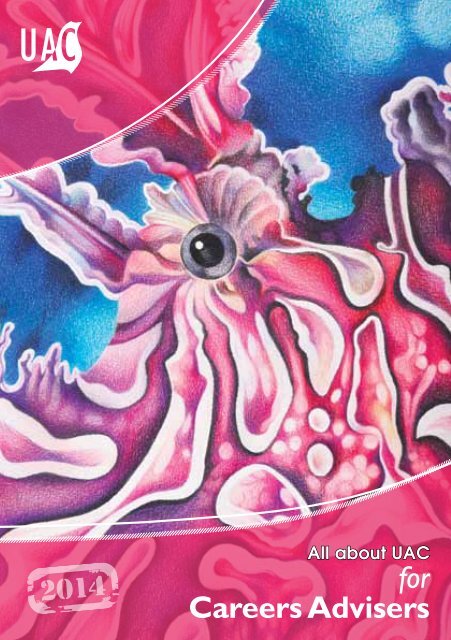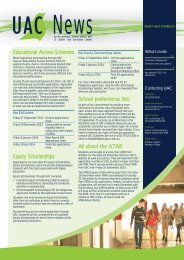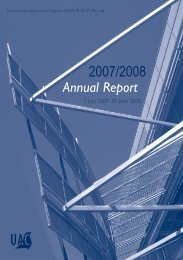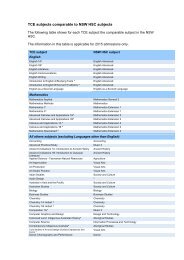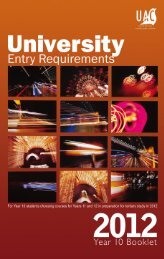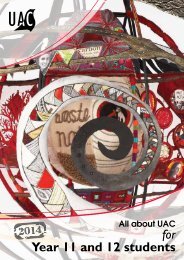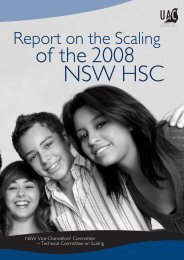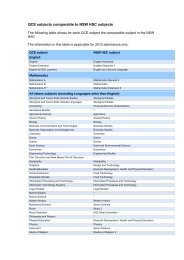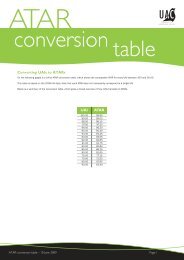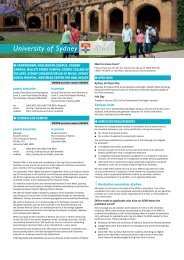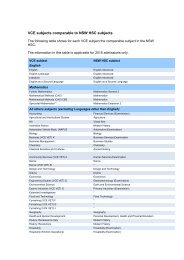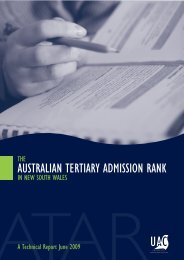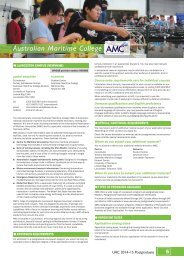about UAC: FAQs for Careers Advisers - Universities Admissions ...
about UAC: FAQs for Careers Advisers - Universities Admissions ...
about UAC: FAQs for Careers Advisers - Universities Admissions ...
Create successful ePaper yourself
Turn your PDF publications into a flip-book with our unique Google optimized e-Paper software.
All <strong>about</strong> <strong>UAC</strong><br />
<strong>for</strong><br />
<strong>Careers</strong> <strong>Advisers</strong>
Contacting <strong>UAC</strong><br />
Important in<strong>for</strong>mation<br />
<strong>UAC</strong><br />
in person<br />
Locked Bag 112<br />
Quad 2, 8 Parkview Drive<br />
Silverwater NSW 2128 Sydney Olympic Park NSW 2127<br />
<strong>UAC</strong> customer service<br />
telephone<br />
8.30am–4.30pm (02) 9752 0200<br />
(Sydney local time)<br />
Monday–Friday<br />
website<br />
www.uac.edu.au<br />
www.youtube.com/<br />
user/<strong>UAC</strong>info<br />
© <strong>Universities</strong> <strong>Admissions</strong> Centre<br />
(NSW & ACT) Pty Ltd 2014<br />
ACN 070 055 935<br />
ABN 19 070 055 935<br />
Printed March 2014<br />
www.facebook.com/<br />
universitiesadmissionscentre<br />
http://twitter.com/<br />
<strong>UAC</strong>info<br />
<strong>UAC</strong> is the owner of the copyright in this publication.<br />
Apart from any fair dealing <strong>for</strong> the purpose of private study, criticism or<br />
review, or otherwise as permitted under the Copyright Act, no part may<br />
be reproduced by any process without <strong>UAC</strong>’s written permission. Enquiries<br />
should be addressed to the Managing Director, <strong>UAC</strong>.<br />
<strong>UAC</strong> has no objection to schools and tertiary institutions reproducing the<br />
publication provided it is <strong>for</strong> use only within their own institution and this<br />
copyright statement is included.<br />
If the document isn’t reproduced in full, sections shouldn’t be copied<br />
out of context where in<strong>for</strong>mation could be incomplete and/or misleading.<br />
Schools and tertiary institutions must ensure that this in<strong>for</strong>mation isn’t<br />
transmitted to any other person or body without prior permission from <strong>UAC</strong>.<br />
This publication is available on <strong>UAC</strong>’s website.<br />
About this publication<br />
All <strong>about</strong> <strong>UAC</strong> <strong>for</strong> <strong>Careers</strong> <strong>Advisers</strong> is based on questions that careers<br />
advisers frequently ask <strong>UAC</strong>. It will help you give accurate advice on high<br />
school students <strong>about</strong> maximising their chances of being accepted into<br />
a tertiary course, from choosing HSC subjects all the way through to the<br />
application process and receiving offers from tertiary institutions.<br />
<strong>UAC</strong> Privacy Policy<br />
The <strong>Universities</strong> <strong>Admissions</strong> Centre (NSW & ACT) Pty<br />
Ltd (<strong>UAC</strong>) recognises the importance of protecting<br />
personal in<strong>for</strong>mation and is bound by the NSW State<br />
In<strong>for</strong>mation Protection Principles 1 , the National Privacy<br />
Principles 2 , the Australian Privacy Principles 3 and the<br />
NSW Health Privacy Principles 4 .<br />
Details of the <strong>UAC</strong> Privacy Policy are available at<br />
www.uac.edu.au/general/privacy.shtml<br />
<strong>UAC</strong> collects personal in<strong>for</strong>mation from applicants<br />
and, in some circumstances, in<strong>for</strong>mation regarding<br />
their health or a family member’s health, <strong>for</strong> the<br />
purpose of processing applications. <strong>UAC</strong> will only<br />
collect in<strong>for</strong>mation <strong>for</strong> lawful purposes related to its<br />
function. Applicants may seek access to the personal<br />
in<strong>for</strong>mation <strong>about</strong> themselves collected by <strong>UAC</strong>.<br />
The type of personal in<strong>for</strong>mation <strong>UAC</strong> holds includes<br />
contact details (name, address, telephone number,<br />
email address), date of birth, gender, citizenship,<br />
in<strong>for</strong>mation relating to the applicant’s health or the<br />
health of a family member, educational achievements,<br />
employment experience, examination results and the<br />
Australian Tertiary Admission Rank (ATAR).<br />
Year 12 results from NSW Higher School Certificate<br />
students are held, along with Year 12 results<br />
from other states and territories in Australia, in an<br />
archive database at <strong>UAC</strong>. If a student is eligible <strong>for</strong><br />
an ATAR or a Limited ATAR, these will also be held<br />
in the database. Results, including ATARs, will also<br />
be held in similar archives at tertiary admissions<br />
centres in other states in Australia. Results held in<br />
these archives will only be accessed by the relevant<br />
tertiary admission centre if the applicant initiates an<br />
application <strong>for</strong> tertiary study through that centre, or if<br />
they submit an application <strong>for</strong> tertiary study directly<br />
with an institution participating in that centre.<br />
Any questions regarding privacy at <strong>UAC</strong> should be<br />
<strong>for</strong>warded in writing to:<br />
The Managing Director<br />
<strong>UAC</strong>, Locked Bag 112<br />
Silverwater NSW 2128.<br />
1 In the Privacy and Personal In<strong>for</strong>mation Protection Act<br />
1998 (NSW).<br />
2 In the Privacy Act 1988 (Cth) as amended in the Privacy<br />
Amendment (Private Sector) Act 2000 (Cth).<br />
3 In the Privacy Amendment (Enhancing Privacy Protection)<br />
Act 2012 (Cth), effective 12 March 2014.<br />
4 In the Health Records and In<strong>for</strong>mation Privacy Act 2002<br />
(NSW).
Contents<br />
All <strong>about</strong> <strong>UAC</strong> <strong>for</strong> <strong>Careers</strong> <strong>Advisers</strong><br />
Introduction &<br />
common terms 2<br />
Year 10 students 5<br />
HSC subject choice 6<br />
The <strong>UAC</strong> Year 10 booklet 7<br />
Year 11 students 8<br />
HSC subject choice 9<br />
Accelerated studies 10<br />
VET courses 10<br />
Year 12 students 11<br />
ATAR 12<br />
Applying 15<br />
Additional selection criteria 17<br />
Educational Access<br />
Schemes (EAS) 18<br />
Financial assistance 19<br />
Offers to domestic students 21<br />
International students 22<br />
Cover image<br />
Natalie Chrisson<br />
Bethany College<br />
The Genius of Evolution<br />
My artwork is inspired by the beauty and diversity of the many species within nature. The animals depicted in my drawings<br />
have adapted to their environments through their unique camouflage. The detailed drawings show their complex structures<br />
and reveal their beauty, acquired through the process of evolution. I began my work by observing numerous photographs and<br />
documentaries, especially David Attenborough’s ‘Life’ series. Then, through a process of selection, I chose the subjects <strong>for</strong> my<br />
drawings and brought them to life through the medium of coloured pencil, focusing on the unique combinations of colours,<br />
patterns and textures that can be found throughout nature.<br />
ARTEXPRESS<br />
ARTEXPRESS is an annual exhibition of outstanding works selected from the NSW Higher School Certificate<br />
examination in Visual Arts. ARTEXPRESS is a joint project of the NSW Department of Education and Communities<br />
and the NSW Board of Studies in association with the Art Gallery of NSW. On display at the Art Gallery of New<br />
South Wales, Hazelhurst Regional Gallery and Arts Centre, The Armory, Sydney Olympic Park, McGlade Art<br />
Gallery, Australian Catholic University and the Margaret Whitlam Gallery, University of Western Sydney<br />
from February to September, as well as touring regional galleries throughout NSW.
Introduction &<br />
common terms
Introduction & common terms<br />
INTRODUCTION<br />
All <strong>about</strong> <strong>UAC</strong> <strong>for</strong> <strong>Careers</strong> <strong>Advisers</strong> has been<br />
produced to help professional careers advisers give<br />
advice to high school students <strong>about</strong> maximising their<br />
chances of being accepted into tertiary education.<br />
The booklet is divided into chronological sections,<br />
from advising Year 10 students on their subject<br />
choice to guiding Year 12 students through the<br />
university application process. Each section<br />
contains an overview of the topic followed by the<br />
answers to the questions <strong>UAC</strong> frequently receives<br />
from careers advisers throughout the year. For<br />
those requiring additional in<strong>for</strong>mation, links to<br />
online resources are provided.<br />
COMMON TERMS<br />
Additional selection criteria<br />
Used by some institutions as well as, or instead<br />
of, the ATAR to assess specific skills relevant<br />
to a particular course. They can include tests,<br />
interviews, auditions and portfolios.<br />
Apply<br />
<strong>UAC</strong>’s online application system on <strong>UAC</strong>’s website.<br />
Year 12 students must apply online through<br />
Undergraduate Apply to be considered <strong>for</strong> a place in<br />
one of <strong>UAC</strong>’s participating institutions. International<br />
students undertaking Year 12 at an Australian high<br />
school need to apply through International Apply.<br />
Assumed knowledge<br />
Knowledge of a specific Year 12 course that an<br />
institution assumes students have be<strong>for</strong>e they start<br />
a particular tertiary course. If students do not have<br />
that assumed level of knowledge but have met the<br />
admission requirements, they could still be selected<br />
<strong>for</strong> the course, but may have difficulty coping with<br />
their studies.<br />
ATAR (Australian Tertiary Admission<br />
Rank)<br />
Measures a student’s overall academic<br />
achievement in Year 12 in relation to their age<br />
cohort. The ATAR is a rank, not a mark. It helps<br />
institutions rank applicants <strong>for</strong> selection.<br />
Check & Change<br />
<strong>UAC</strong>’s online facility that enables applicants to<br />
check and change their preferences and other<br />
details on their application.<br />
Cohort<br />
A student’s peer group. For example, the ATAR<br />
cohort refers to those students who receive<br />
an ATAR in the same academic year. A Year 7<br />
cohort comprises those students who began<br />
Year 7 together, regardless of when they left<br />
the school system.<br />
Course<br />
A branch of study within a NSW HSC subject.<br />
A subject may have several different courses.<br />
For example, within the subject of English,<br />
courses include English (Standard),<br />
English (Advanced), English Extension 1,<br />
English Extension 2, and English as a<br />
Second Language.<br />
Course cut-off<br />
The lowest selection rank (including any bonuses)<br />
obtained by current Australian Year 12 students<br />
receiving an offer to a course. The cut-offs <strong>for</strong><br />
courses in a particular year are only known<br />
after Main Round offers <strong>for</strong> that year are made.<br />
The previous year’s cut-offs can only be used as<br />
a guide.<br />
Course cut-offs can change from year to year,<br />
depending on the number of places available,<br />
the number of applications <strong>for</strong> the course<br />
and the quality of the applicants.<br />
3
Deferment<br />
When a student receives an offer to enrol in a<br />
tertiary course but has been given permission by<br />
the institution to delay the start of the course <strong>for</strong> a<br />
fixed period, usually one year.<br />
HSC mark<br />
A 50:50 combination of a student’s examination<br />
mark and school-based assessment mark <strong>for</strong><br />
each course. It is recorded on the student’s HSC<br />
Record of Achievement, which is posted to them<br />
by the Board of Studies, Teaching and Educational<br />
Standards (BOSTES).<br />
Institution<br />
A provider of tertiary study, such as a university or<br />
a college.<br />
Moderation<br />
The process of adjusting school assessment marks<br />
to a common scale so that direct comparisons can<br />
be made between assessment marks awarded by<br />
different schools. The rank order of students within<br />
a school group, and the relative gaps between<br />
them, are maintained.<br />
Prerequisite<br />
An essential prescribed level of achievement that<br />
must be reached in order to be considered <strong>for</strong><br />
admission to certain tertiary courses. Some tertiary<br />
courses require you to have achieved a specified<br />
standard in an HSC course or equivalent be<strong>for</strong>e<br />
you will be offered a place in those courses (course<br />
prerequisites). Some subjects within a tertiary<br />
course require you to achieve a specified standard<br />
in a particular HSC course or equivalent be<strong>for</strong>e<br />
you are able to enrol in those particular subjects<br />
(subject prerequisites). Some institutions offer<br />
bridging or introductory courses to help you achieve<br />
the required standard.<br />
Raw HSC mark<br />
The average of a student’s raw examination mark<br />
and their raw moderated school assessment<br />
mark, be<strong>for</strong>e it is aligned to per<strong>for</strong>mance bands<br />
by the Board of Studies, Teaching and Educational<br />
Standards (BOSTES) or scaled by <strong>UAC</strong>. This mark is<br />
not reported to the student.<br />
Recommended studies<br />
Year 12 courses that an institution suggests a<br />
student should study to assist in their chosen tertiary<br />
course. If a student has not studied these courses<br />
their chances of selection are not affected. However,<br />
a student who has studied these courses will be<br />
better prepared <strong>for</strong> their chosen tertiary course.<br />
Scaled mark<br />
The mark used in the ATAR calculation. It is used<br />
because marks in different courses are not directly<br />
comparable, and an adjustment must be made<br />
be<strong>for</strong>e an overall measure of achievement can<br />
be determined. Scaling allows the comparison of<br />
students who have studied different courses by<br />
determining what the marks would have been if all<br />
students had attempted all courses.<br />
Subject<br />
A general area of study or key learning area in the<br />
NSW HSC; <strong>for</strong> example English or mathematics.<br />
<strong>Universities</strong> <strong>Admissions</strong> Centre (<strong>UAC</strong>)<br />
The central office that receives and processes<br />
applications <strong>for</strong> admission to most undergraduate<br />
courses at its participating institutions as well<br />
as applications <strong>for</strong> Educational Access Schemes<br />
and Equity Scholarships. <strong>UAC</strong> notifies NSW HSC<br />
students of their ATAR (ACT students are notified<br />
by their school) and makes offers of admission on<br />
behalf of participating institutions. It also processes<br />
applications <strong>for</strong> many postgraduate courses.<br />
4
Year 10 students<br />
5
HSC SUBJECT CHOICE<br />
In Year 10 students begin to think <strong>about</strong> what<br />
subjects and courses to study in years 11 and 12<br />
if they intend to pursue tertiary education. They<br />
may have heard rumours from older students<br />
and siblings <strong>about</strong> Year 12, the ATAR or university<br />
entry. It is important to dispel myths and to give<br />
students solid in<strong>for</strong>mation on which they can base<br />
their decisions.<br />
<strong>UAC</strong> has developed resources to assist careers<br />
advisers and students at this crucial stage,<br />
including the university entry requirements booklet<br />
<strong>for</strong> Year 10 students and accompanying PowerPoint<br />
presentation.<br />
These resources can be accessed on <strong>UAC</strong>’s<br />
Schoolink website at www.uac.edu.au/schoolink/<br />
year-10.shtml<br />
How should I advise Year 10<br />
students who want to go on to<br />
tertiary study<br />
<strong>UAC</strong> recommends encouraging Year 10 students to<br />
choose HSC courses they enjoy and are good at, and<br />
which will prepare them <strong>for</strong> what they are planning to<br />
study after Year 12. They should select courses that<br />
give them some flexibility and allow entry into a range<br />
of tertiary courses. <strong>UAC</strong> does not recommend that<br />
students select a course based only on its perceived<br />
ATAR value.<br />
The most important thing <strong>for</strong> students intending to go<br />
on to further study is to make sure that they choose<br />
(and continue with) a pattern of study that will make<br />
them eligible <strong>for</strong> an ATAR.<br />
Are there any HSC courses that<br />
students can choose to maximise<br />
their ATAR<br />
Students can achieve a high ATAR regardless of the<br />
HSC courses they study, as their ATAR will depend on<br />
their positions in all of their courses. Students who<br />
achieve high ATARs are generally placed near the top<br />
in all of their courses.<br />
Remember, to be eligible <strong>for</strong> an ATAR, students must<br />
satisfactorily complete at least 10 units of ATAR<br />
courses, including:<br />
• eight units from Category A courses<br />
• two units of English<br />
• three Board Developed courses of two units<br />
or greater<br />
• four subjects. (A subject is a general area of<br />
study, such as English. Within that subject<br />
there may be a number of courses, such<br />
as English (Standard), English (Advanced),<br />
English Extension 1, English Extension 2<br />
and English as a Second Language.)<br />
Only two units of Category B courses can be included<br />
in the calculation of the ATAR.<br />
Are there any prerequisite courses<br />
that Year 10 students need to be<br />
aware of<br />
Very few universities in NSW and the ACT have<br />
courses with prerequisites. However, students<br />
should also take careful note of assumed knowledge<br />
and recommended studies. It is better to have a<br />
background in an area of study across Years 10,<br />
11 and 12 than to undertake an intensive bridging<br />
course when university begins.<br />
<strong>UAC</strong>’s university entry requirements booklet <strong>for</strong><br />
Year 10 students helps them select courses<br />
<strong>for</strong> years 11 and 12. It sets out course entry<br />
requirements <strong>for</strong> all <strong>UAC</strong> participating institutions,<br />
and includes details of how the ATAR is calculated<br />
and used <strong>for</strong> tertiary entry.<br />
6
Year 10 students<br />
Many interstate institutions do have prerequisites.<br />
Students need to be advised to look at the websites<br />
or publications produced by interstate institutions<br />
and tertiary admissions centres to check those<br />
prerequisites.<br />
THE <strong>UAC</strong> YEAR 10 BOOKLET<br />
<strong>UAC</strong>’s university entry requirements booklet <strong>for</strong><br />
Year 10 students is published every year around<br />
May and is aimed at Year 10 students who are<br />
considering tertiary study. Four complimentary<br />
copies are sent to each school and extra copies<br />
can be purchased through or downloaded from<br />
<strong>UAC</strong>’s website.<br />
When using the Year 10 booklet, students should<br />
pay careful attention to the following in<strong>for</strong>mation:<br />
• Course prerequisites: Some tertiary courses<br />
require a student to have achieved a certain<br />
standard in an HSC course or equivalent<br />
be<strong>for</strong>e they will be offered a place in that course.<br />
• Subject prerequisites: Some subjects in tertiary<br />
courses require a student to have achieved<br />
a certain standard in a specific HSC course<br />
be<strong>for</strong>e the student is able to enrol in those<br />
particular subjects.<br />
• Assumed knowledge: Some institutions<br />
assume a student has knowledge of specific<br />
HSC courses or equivalent be<strong>for</strong>e they begin<br />
the course.<br />
• Recommended studies: These are HSC<br />
or equivalent courses that the institutions<br />
suggest will help a student in their chosen<br />
tertiary course.<br />
Although NSW institutions have few prerequisites<br />
and many offer bridging courses where required<br />
subjects or standards are not met, students need to<br />
consider the importance of assumed knowledge and<br />
recommended studies. Remember that a bridging<br />
course may add significantly to a student’s study load.<br />
How do I use the Year 10 booklet<br />
<strong>UAC</strong>’s Year 10 booklet helps students select<br />
courses <strong>for</strong> years 11 and 12. It includes a table and<br />
worksheets to help students map their interests and<br />
skills to some possible career paths and study options<br />
and select useful HSC subjects. It also sets out course<br />
entry requirements <strong>for</strong> <strong>UAC</strong>’s participating institutions,<br />
including prerequisites, assumed knowledge<br />
and recommended studies. The Year 10 booklet<br />
PowerPoint presentation provided on <strong>UAC</strong>’s website is<br />
a useful resource <strong>for</strong> a ‘subject selection’ lesson.<br />
What else is in the Year 10 booklet<br />
The booklet lists university open days to encourage<br />
students to begin researching their options by<br />
visiting campuses. It also provides in<strong>for</strong>mation <strong>about</strong><br />
HSC courses and whether they are classified as<br />
Category A or Category B. The booklet also includes<br />
in<strong>for</strong>mation <strong>about</strong> how the ATAR is calculated and<br />
used <strong>for</strong> tertiary entry.<br />
How do I order additional copies of<br />
the booklet<br />
In addition to the four free copies provided to each<br />
school, you can order the booklet online from<br />
the <strong>UAC</strong> shop. Visit www.uac.edu.au/schoolink/ and<br />
pay online by credit card, or by cheque. Booklets are<br />
dispatched from early May on receipt of payment.<br />
To view a PowerPoint presentation on the <strong>UAC</strong><br />
Year 10 booklet, visit www.uac.edu.au/schoolink/<br />
year-10.shtml<br />
7
8<br />
Year 11 students
Year 11 students<br />
HSC SUBJECT CHOICE<br />
This section is <strong>for</strong> careers advisers who are helping<br />
Year 11 students with their subject choices. It can<br />
be read in conjunction with <strong>UAC</strong>’s publication,<br />
All <strong>about</strong> <strong>UAC</strong> <strong>for</strong> Year 11 and 12 Students.<br />
How many subjects should Year 11<br />
students undertake<br />
To complete the HSC and receive an ATAR, students<br />
must undertake at least 12 units of ATAR courses<br />
in Year 11 and at least 10 units in Year 12. Doing<br />
more than 12 units in Year 11 is not necessary but<br />
it may be worthwhile <strong>for</strong> able students to broaden<br />
their scope of study, giving them greater choice when<br />
it’s time to refine their course choice <strong>for</strong> Year 12.<br />
Students need to ensure that the courses they take<br />
in years 11 and 12 make them eligible <strong>for</strong> an ATAR.<br />
How should I advise Year 11 students<br />
who are finalising their courses <strong>for</strong><br />
Year 12<br />
<strong>UAC</strong> recommends encouraging Year 11 students<br />
to choose courses they enjoy and are good at, and<br />
which will prepare them <strong>for</strong> what they are planning to<br />
study after Year 12. They should select courses that<br />
give them some flexibility and allow entry into a range<br />
of tertiary courses. <strong>UAC</strong> does not recommend that<br />
students select a course based only on its perceived<br />
ATAR value.<br />
If students wish to drop courses at<br />
the end of Year 11, should they first<br />
check the Scaling Report be<strong>for</strong>e<br />
making any decisions<br />
The most important thing <strong>for</strong> Year 11 students<br />
to keep in mind is to make sure they will still<br />
be eligible <strong>for</strong> an ATAR if they drop any courses.<br />
Remember, to be eligible <strong>for</strong> an ATAR students<br />
must satisfactorily complete at least 10 units of<br />
ATAR courses, including:<br />
• eight units from Category A courses<br />
• two units of English<br />
• three Board Developed courses of two units<br />
or greater<br />
• four subjects. (A subject is a general area of<br />
study, such as English. Within that subject<br />
there may be a number of courses, such as<br />
English (Standard), English (Advanced), English<br />
Extension 1, English Extension 2 and English as<br />
a Second Language.)<br />
<strong>UAC</strong> does not recommend that students select a<br />
course based only on its perceived ATAR value.<br />
The best way <strong>for</strong> students to maximise their<br />
ATAR is to choose courses they will do well in.<br />
Is a Band 4 or 5 in English<br />
(Advanced) better than a Band 6 in<br />
English (Standard) Is it better <strong>for</strong><br />
a student who is good at English,<br />
but dislikes it, to drop English<br />
(Advanced) and study English<br />
(Standard)<br />
It is very difficult to predict which course will<br />
receive a higher scaled mark. Even if we could<br />
make this prediction it wouldn’t necessarily<br />
benefit the student if their position in the<br />
course is low. Advice should be based on<br />
which of the two courses the student prefers<br />
and will there<strong>for</strong>e do better in. This is<br />
particularly relevant <strong>for</strong> English because it<br />
has to be included no matter how well or<br />
poorly the student per<strong>for</strong>ms.<br />
9
ACCELERATED STUDIES<br />
Some students may accelerate their studies by<br />
completing HSC courses while in Year 11. This can<br />
offer advantages such as:<br />
• letting students take fewer courses in Year 12,<br />
meaning they can focus on those units<br />
• allowing students to study a broader range of<br />
subjects<br />
• having more units available <strong>for</strong> inclusion in the<br />
calculation of their ATAR.<br />
If a student completes a course in<br />
Year 11, who are they ranked with<br />
Courses are scaled in the year they are completed<br />
and the scaled mark is available <strong>for</strong> inclusion in the<br />
ATAR calculation when the student becomes ATAR<br />
eligible. The student is ranked with others in the<br />
same ATAR cohort.<br />
Take the example of a Year 11 student below:<br />
Year HSC course Scaling<br />
2013 Agriculture Results scaled against other<br />
students completing that course<br />
in 2013<br />
2014 10 additional<br />
HSC units<br />
Results scaled against other<br />
students completing those units<br />
in 2014<br />
Can a Category B course completed<br />
in Year 11 be included in a student’s<br />
ATAR calculation<br />
Yes. Any course completed in Year 11 will be available<br />
<strong>for</strong> inclusion in the ATAR calculation. Whether it is<br />
actually included will depend on whether it is among<br />
the student’s best eight scaled units (after English).<br />
Remember also that <strong>for</strong> a Category B course to be<br />
included in the ATAR calculation, the examination<br />
must be completed. There<strong>for</strong>e, schools must ensure<br />
that students who are studying Category B courses<br />
and who will be eligible <strong>for</strong> an ATAR are enrolled<br />
with the Board of Studies, Teaching and Educational<br />
Standards (BOSTES) <strong>for</strong> the course and the exam.<br />
No more than two units of Category B courses can be<br />
included in the ATAR calculation.<br />
If a student completes<br />
Mathematics in Year 11 and then<br />
goes on to complete Mathematics<br />
Extension 1 and Mathematics<br />
Extension 2, will Mathematics still<br />
be available <strong>for</strong> inclusion in the<br />
student’s ATAR<br />
No. The result in Mathematics will be replaced<br />
by the results in Mathematics Extension 1 and<br />
Mathematics Extension 2.<br />
VET COURSES<br />
Vocational education and training (VET) courses<br />
provide students with the opportunity to<br />
gain industry-recognised national vocational<br />
qualifications under the Australian Qualifications<br />
Framework (AQF) as part of their schooling.<br />
VET courses (Industry Curriculum Frameworks<br />
or VET Board Endorsed Courses) are based on<br />
qualifications and units of competency contained<br />
in nationally endorsed Training Packages.<br />
Are TVET courses Category B<br />
courses, and do they contribute<br />
to the ATAR<br />
Some TAFE-delivered HSC VET (TVET) courses<br />
are Category B courses. Others are endorsed by<br />
the Board of Studies, Teaching and Educational<br />
Standards (BOSTES) and contribute to the HSC,<br />
but not to the ATAR.<br />
Category B courses are Board Developed VET<br />
courses or Industry Curriculum Framework (ICF)<br />
courses. They can contribute to the ATAR as long<br />
as students sit <strong>for</strong> the optional examination. No<br />
more than two units of Category B courses can be<br />
included in the ATAR calculation.<br />
10
Year 12 students<br />
11
ATAR<br />
The Australian Tertiary Admission Rank (ATAR) is<br />
a number between 0.00 and 99.95. It provides<br />
a measure of a student’s overall academic<br />
achievement in Year 12 in relation to their age<br />
cohort, and it helps institutions rank applicants <strong>for</strong><br />
selection. In NSW the ATAR is released by <strong>UAC</strong>. In<br />
the ACT the ATAR is released by schools.<br />
For NSW HSC students the ATAR is based on an<br />
aggregate of scaled marks in 10 units of ATAR<br />
courses, which must include two units of English.<br />
It is important to remember that the ATAR is a rank,<br />
not a mark. A student’s ATAR depends not only on<br />
their position in the courses they study, but on the<br />
ability of the other students in those courses. These<br />
factors affect the scaled mean of each course. In<br />
contrast, HSC marks provide in<strong>for</strong>mation <strong>about</strong> how<br />
well a student has achieved in each of the courses<br />
they have completed. ATARs and HSC marks are<br />
calculated separately using different methods.<br />
My school has students who will<br />
receive a Limited ATAR. How does<br />
it work<br />
Students who are over 20 years of age on 1 March<br />
in the year they complete their HSC studies and<br />
who are taking between five and nine units of ATAR<br />
courses, including at least one unit of English, are<br />
eligible <strong>for</strong> a Limited ATAR. Some institutions use the<br />
Limited ATAR together with other criteria <strong>for</strong> selection<br />
purposes.<br />
For a Limited ATAR, all courses must be completed<br />
in the same academic year. Students cannot<br />
accumulate courses over several years.<br />
For more in<strong>for</strong>mation <strong>about</strong> the Limited ATAR, visit<br />
www.uac.edu.au/undergraduate/atar/<br />
limited-atar.shtml<br />
Can a student receive both a<br />
Limited ATAR and an ATAR<br />
Yes. If a student meets the criteria to receive a<br />
Limited ATAR and an ATAR, both will be calculated<br />
and sent to them. The student will receive a Limited<br />
ATAR Advice Notice and an ATAR Advice Notice.<br />
However, students usually receive a Limited ATAR in<br />
one year and an ATAR in a later year, once they have<br />
completed the required number of units.<br />
For more details <strong>about</strong> the ATAR, visit <strong>UAC</strong>’s<br />
website at www.uac.edu.au/undergraduate/atar/<br />
How is the Limited ATAR calculated<br />
The Limited ATAR is calculated using the scaled<br />
marks from ATAR courses, which must include at<br />
least one unit of English plus the best four other<br />
units of Category A courses.<br />
Why do some courses scale better<br />
than others<br />
Courses have to be scaled so that marks in<br />
different courses can be compared with each<br />
other. Courses are scaled using the mean scores<br />
and distribution of marks, which indicate the<br />
ability of the course candidature. Courses such as<br />
Mathematics Extension 2 and Physics traditionally<br />
scale well because of this. However, students<br />
must achieve high HSC marks to gain any benefit<br />
from scaling.<br />
How many units of maths can be<br />
included in the calculation of the<br />
ATAR<br />
Up to four units of maths can be included in the<br />
ATAR calculation. Students studying Mathematics<br />
Extension 1 should be aware that it has a different<br />
weighting (in terms of units) depending on whether<br />
Mathematics or Mathematics Extension 2 is taken.<br />
If students study Mathematics (2 units), then<br />
Mathematics Extension 1 accounts <strong>for</strong> 1 unit.<br />
If students study Mathematics Extension 2 (2 units),<br />
then Mathematics Extension 1 accounts <strong>for</strong> 2 units.<br />
If a student completes Mathematics then goes on<br />
to satisfactorily complete Mathematics Extension 1<br />
and Mathematics Extension 2, their results in<br />
Mathematics will not be included in the ATAR<br />
calculation, even if they have excelled in it.<br />
12
Year 12 students<br />
If a student does English<br />
(Advanced), English Extension 1<br />
and Extension 2, which units will<br />
be included in the calculation of<br />
the ATAR<br />
The ATAR is calculated using the scaled marks<br />
from a student’s best two units of English, plus<br />
their next eight best units. If a student’s additional<br />
English units are among their next best eight units,<br />
they can also be used in their ATAR calculation.<br />
Can courses be accumulated<br />
Yes. Courses can be accumulated <strong>for</strong> the ATAR<br />
over a period of up to five years. Scaled marks<br />
are calculated in the year the course is completed.<br />
If a student repeats an HSC<br />
course, will their best mark be<br />
included in the calculation of<br />
their new ATAR<br />
Not necessarily. If a student repeats a course,<br />
only the marks <strong>for</strong> the latest satisfactory attempt<br />
will be available <strong>for</strong> inclusion in the calculation of<br />
their ATAR, even if they are lower than the earlier<br />
attempt.<br />
If a student is ranked second in a<br />
school assessment, does that mean<br />
they will receive the second highest<br />
exam mark<br />
No. A student who is ranked second in their<br />
school assessment will receive the second highest<br />
moderated assessment mark. The exam mark the<br />
student receives will depend on how well the student<br />
per<strong>for</strong>ms in the exam and is independent of their<br />
assessment rank.<br />
So having one under‐per<strong>for</strong>ming student in the exam<br />
is unlikely to make any difference. If all the students<br />
in your school under‐per<strong>for</strong>m in the exam, the school<br />
assessment marks will be moderated downwards.<br />
Conversely, if your students do well in the exam,<br />
your school’s assessment marks will be moderated<br />
upwards.<br />
For a detailed explanation of scaling, read the<br />
Scaling Report at www.uac.edu.au/undergraduate/<br />
atar/report.shtml Contact the Board of Studies,<br />
Teaching and Educational Standards (BOSTES) <strong>for</strong><br />
more in<strong>for</strong>mation on moderation.<br />
If a student’s HSC paper has been<br />
re-marked, will a new ATAR be<br />
calculated<br />
If the Board of Studies, Teaching and Educational<br />
Standards (BOSTES) provides <strong>UAC</strong> with amended<br />
HSC results, the student’s ATAR is automatically<br />
recalculated and the student notified by email by<br />
<strong>UAC</strong>. A new ATAR Advice Notice will also be sent to<br />
the student.<br />
Is a student’s ATAR calculation<br />
influenced by the school they<br />
attend<br />
No. The ATAR calculation is based on 10 units of a<br />
student’s scaled marks, and the school a student<br />
attends does not <strong>for</strong>m part of the calculation.<br />
All students can per<strong>for</strong>m well regardless of the<br />
school they attend, provided they study hard and<br />
achieve good HSC results. You can encourage<br />
students to achieve their personal best by choosing<br />
courses that they enjoy and are good at. In 2013,<br />
students who achieved ATARs of 99.95 came from<br />
a mix of government (both comprehensive and<br />
selective) and non-government schools.<br />
If I have an under-per<strong>for</strong>ming<br />
student, will this bring down<br />
everybody else’s marks<br />
Not necessarily. School assessment marks are<br />
moderated against the exam marks to eliminate any<br />
differences between schools in the way they assess.<br />
Are there plans to include<br />
Year 9 NAPLAN results in<br />
future ATAR calculations<br />
No. The ATAR calculation is based<br />
solely on HSC results. No other<br />
school results are used.<br />
13
Does the ATAR reflect a student’s<br />
rank against all other Year 12<br />
students in Australia<br />
No. ATARs are calculated in each state (except<br />
Queensland) to reflect a student’s rank against other<br />
students in their state. An ATAR of 85.00 in NSW<br />
will, however, be considered equivalent to an ATAR of<br />
85.00 in other states.<br />
Is it mandatory in all states <strong>for</strong><br />
English to be included in the<br />
calculation of the ATAR<br />
No. It is not compulsory in all states. However, in<br />
NSW it is mandatory <strong>for</strong> two units of English to be<br />
included in the ATAR calculation.<br />
What should I do if I have a student<br />
who has completed subjects in<br />
another state and wants them<br />
included in the calculation of their<br />
ATAR<br />
The student should contact the Board of Studies,<br />
Teaching and Educational Standards (BOSTES) to<br />
gain approval to include the subjects in the HSC.<br />
The student should then make a request in writing to<br />
the Director, In<strong>for</strong>mation Services, <strong>UAC</strong>, Locked Bag<br />
112, Silverwater NSW 2128.<br />
Why is 100 no longer the top rank<br />
In 2009, the <strong>Universities</strong> Admission Index (UAI)<br />
became the Australian Tertiary Admission Rank<br />
(ATAR) and the top rank was changed from a UAI of<br />
100 to an ATAR of 99.95. This was done to create<br />
a uni<strong>for</strong>m top rank of 99.95 across all states<br />
(except Queensland).<br />
If a student does 12 units, will they<br />
know which 10 units have been used<br />
in their ATAR calculation<br />
Yes. This in<strong>for</strong>mation is included on the ATAR Advice<br />
Notice that students receive in the mail.<br />
Students need to ensure that <strong>UAC</strong> and the Board<br />
of Studies, Teaching and Educational Standards<br />
(BOSTES) have their up-to-date postal and email<br />
addresses so that they receive their ATAR Advice<br />
Notice and other important correspondence.<br />
Can English Studies be included<br />
in the calculation of a student’s<br />
ATAR<br />
No. This course has no external HSC examination<br />
and cannot be included in the ATAR calculation.<br />
Why is the Year 7 cohort used in<br />
the ATAR calculation<br />
Each state has different participation rates; that<br />
is, the number of students completing Year 12<br />
who are eligible to receive an ATAR. To ensure the<br />
interstate equivalence of ATARs, an age cohort is<br />
used in each state so that a student’s rank is a<br />
measure of their per<strong>for</strong>mance against all students<br />
who started Year 7 with them in that state, not just<br />
those who completed Year 12 and were eligible<br />
<strong>for</strong> an ATAR.<br />
A more detailed explanation can be found in the<br />
Report on the Scaling of the NSW Higher School<br />
Certificate available on <strong>UAC</strong>’s website at<br />
www.uac.edu.au/undergraduate/atar/reports.shtml<br />
14
Year 12 students<br />
Can a student get a high ATAR even<br />
though they study courses such as<br />
Visual Arts, Business Studies and<br />
Hospitality<br />
Yes. It is possible to achieve a high ATAR regardless<br />
of courses studied. However, it is important to note<br />
that students who achieve very high ATARs are usually<br />
placed in the top group of students in all of their<br />
courses.<br />
Can <strong>UAC</strong> give me my students’<br />
ATARs<br />
No. An ATAR can only be accessed by a student or<br />
their authorised agent. <strong>UAC</strong> does not give ATARs to<br />
schools or careers advisers. You may ask a student<br />
directly what their ATAR is, but it is the student’s<br />
decision whether or not to tell you.<br />
How have Fred and Laura fared<br />
over the years<br />
Each year, we calculate Fred and Laura’s ATARs using<br />
the same HSC marks. As you will see from the table<br />
below, while their HSC marks are constant, Fred and<br />
Laura’s ATARs change from year to year. However,<br />
there is always a signifi cant difference between them.<br />
Year Fred Laura<br />
2001 61.45 86.50<br />
2002 59.65 84.75<br />
2003 60.80 83.40<br />
2004 60.60 82.40<br />
2005 59.75 82.80<br />
2006 63.30 83.95<br />
2007 61.95 83.30<br />
2008 59.05 82.25<br />
2009 57.80 81.20<br />
2010 57.05 80.15<br />
2011 58.20 79.80<br />
2012 57.45 79.65<br />
2013 57.55 80.00<br />
APPLYING<br />
Most applications are made through <strong>UAC</strong>’s<br />
website. Some courses, however, may require<br />
students to apply directly to the institution,<br />
so students need to check each course’s<br />
requirements carefully.<br />
Applications open from early August each year.<br />
To apply, Year 12 students need their student<br />
number and the four-digit <strong>UAC</strong> PIN sent to them<br />
in early August.<br />
All applicants must pay the relevant processing<br />
charge or their application will not be considered<br />
and they will not receive any offers. The processing<br />
charge <strong>for</strong> Year 12 students in 2013 was $28<br />
(indexed yearly). For applications submitted<br />
between late September and late February, a<br />
progressively higher amount is payable (up to $178<br />
in 2013–14). Payments to <strong>UAC</strong> are not refundable<br />
under any circumstances except as required by law.<br />
After applying, applicants can change their<br />
course preferences and personal details using<br />
Check & Change.<br />
It is important <strong>for</strong> students to keep their <strong>UAC</strong><br />
application number and <strong>UAC</strong> PIN safe and handy,<br />
as they will need them to change their preferences<br />
and check their ATAR and offers online.<br />
Read the FAQ <strong>about</strong> using Apply on <strong>UAC</strong>’s website at<br />
www.uac.edu.au/undergraduate/faq/applying.shtml<br />
and watch the video <strong>about</strong> how to apply at<br />
www.youtube.com/user/<strong>UAC</strong>info<br />
What is the best advice I can give<br />
students to maximise their chances<br />
of getting into the course they<br />
want<br />
The best advice is <strong>for</strong> them to be realistic and<br />
take their application seriously. Course<br />
cut-offs from the previous year are the<br />
best indicators of the rank required<br />
to receive an offer to a course,<br />
and these are published in the<br />
online course search results<br />
on <strong>UAC</strong>’s website and in the<br />
<strong>UAC</strong> Guide.<br />
15
<strong>UAC</strong> recommends students list their ‘dream<br />
preference’ at number one, but follow that with a<br />
number of realistic preferences. At the bottom of the<br />
preference list they should include one or two ‘safe’<br />
options to ensure that they get an offer. To maximise<br />
their chance of receiving an offer, students should<br />
include courses with a range of cut-offs. They should<br />
also tick the box that asks them if they would like to<br />
receive in<strong>for</strong>mation on other study options if they do<br />
not receive an offer to any of their selected courses.<br />
Most importantly, students need to take<br />
responsibility <strong>for</strong> their application by reading all<br />
correspondence from <strong>UAC</strong> and following instructions.<br />
Are students able to apply through<br />
<strong>UAC</strong> at any time during the year<br />
Yes. Undergraduate admissions open in early<br />
August and close in mid‐July the following year.<br />
Provided the relevant course closing dates have not<br />
passed, students can apply <strong>for</strong> courses as part of a<br />
year‐round admissions period.<br />
What are common mistakes that<br />
result in students not getting the<br />
offer they want, or missing out<br />
completely<br />
The most common mistakes <strong>UAC</strong> sees from students<br />
are:<br />
• not understanding the preference system:<br />
——<br />
not listing their most desired course as their<br />
first preference<br />
——<br />
listing unrealistic preferences<br />
——<br />
not changing preferences after they receive<br />
their ATAR to courses with cut-offs more in line<br />
with their actual rank<br />
——<br />
changing preferences but not saving their<br />
changes<br />
——<br />
not removing or moving down the list a<br />
preference they have already received an<br />
offer to, thereby blocking offers to lower<br />
preferences in later rounds<br />
• declining an offer in the January Main Round<br />
in the hope of getting a ‘better’ offer in a later<br />
round<br />
• not paying the processing charge<br />
• not meeting <strong>UAC</strong> deadlines <strong>for</strong> applying,<br />
changing preferences or supplying supporting<br />
documentation<br />
• letting an offer lapse without accepting it<br />
• <strong>for</strong>getting to enrol at the institution.<br />
If students are intending to take<br />
a gap year be<strong>for</strong>e starting tertiary<br />
study, should they apply now<br />
and defer, or wait and apply in<br />
12 months’ time<br />
<strong>UAC</strong> recommends that students intending to take a<br />
gap year apply now and defer. Current Year 12s are<br />
eligible <strong>for</strong> early entry schemes, and regional and<br />
subject bonus points. Any bonus points will improve<br />
their selection rank. In addition, depending on the<br />
institution, Educational Access Schemes and Equity<br />
Scholarships may only be available to current school<br />
leavers.<br />
If students wait a year they will be applying as<br />
non‐Year 12 applicants. They will be competing<br />
against other non-Year 12 applicants who may have<br />
a range of qualifications and experiences. Students<br />
may also no longer have access to bonus points.<br />
What number should students use<br />
to apply<br />
Students should use their Year 12 student number<br />
and <strong>UAC</strong> PIN to log into Apply <strong>for</strong> the first time. Once<br />
they complete and submit their personal details,<br />
their <strong>UAC</strong> application number will be generated.<br />
16
Year 12 students<br />
If work experience is not relevant<br />
<strong>for</strong> Year 12 students, why are they<br />
asked <strong>about</strong> it in Apply<br />
Apply is also used by non-Year 12 applicants, whose<br />
work experience and previous qualifications may be<br />
relevant to their applications.<br />
Year 12 students need to be aware that in nearly<br />
all cases their work experience will not be taken<br />
into consideration as part of their application. Work<br />
experience can only be assessed if the applicant has<br />
worked <strong>for</strong> one year or more on a paid full-time basis,<br />
or its equivalent.<br />
If a New Zealand citizen can apply<br />
as a domestic student, can they<br />
receive HECS-HELP<br />
No. New Zealand citizens are eligible <strong>for</strong><br />
Commonwealth-supported places, meaning their<br />
study is subsidised by the Australian Government,<br />
but they are not eligible <strong>for</strong> HECS‐HELP. New Zealand<br />
students must pay their student contribution<br />
up‐front.<br />
Should HSC students who have<br />
completed a VET course such as<br />
a Certificate III add this to their<br />
<strong>UAC</strong> application as a tertiary<br />
qualification<br />
TAFE and private provider studies at Certificate III<br />
level and above and non-award or Bachelor-level<br />
studies (either complete or incomplete) need to be<br />
added to their application separately as a tertiary<br />
qualification. Only qualifications of Certificate III and<br />
above will be assessed.<br />
ADDITIONAL SELECTION<br />
CRITERIA<br />
Year 12 students are selected on the basis of their<br />
ATAR <strong>for</strong> most courses. However, some courses<br />
have additional selection criteria. These can include<br />
tests, interviews, auditions and portfolios. Students<br />
need to check carefully if any of their courses have<br />
additional selection criteria or particular course<br />
requirements. These can be found in the course<br />
description on <strong>UAC</strong>’s undergraduate course search<br />
at www.uac.edu.au or in the <strong>UAC</strong> Guide.<br />
What types of tests and special<br />
course requirements might apply<br />
to Year 12 students<br />
The requirements <strong>for</strong> particular courses can include<br />
any of the following:<br />
• UMAT (Undergraduate Medicine and Health<br />
Sciences <strong>Admissions</strong> Test)<br />
For students wishing to study medicine and<br />
some health science degree programs, some<br />
universities in NSW require them to sit UMAT.<br />
UMAT is generally held in the middle of the<br />
year, be<strong>for</strong>e the publication of the <strong>UAC</strong> Guide,<br />
so students need to know in advance if UMAT<br />
is required <strong>for</strong> their desired course and register<br />
<strong>for</strong> the test.<br />
• STAT (Special Tertiary <strong>Admissions</strong> Test)<br />
STAT is required by the University of Sydney <strong>for</strong><br />
entry into veterinary science. Other institutions<br />
generally only accept STAT results from non-Year<br />
12 applicants. More in<strong>for</strong>mation on how each<br />
institution uses STAT can be found in the <strong>UAC</strong><br />
Guide or on <strong>UAC</strong>’s website. STAT sittings are held<br />
throughout the year and students can register<br />
through <strong>UAC</strong>’s website.<br />
• Special requirements<br />
Students seeking entry into health-related and<br />
teacher education courses need to be aware of<br />
special requirements relating to:<br />
——<br />
criminal record/working with children<br />
checks<br />
——<br />
clinical placements<br />
——<br />
procedures <strong>for</strong> employment after<br />
completing the course.<br />
For details, visit umat.acer.edu.au/<br />
(UMAT), www.uac.edu.au/stat/<br />
(STAT) and www.uac.edu.au/<br />
undergraduate/admission/<br />
(special requirements)<br />
17
How are STAT and UMAT results<br />
added to a student’s application<br />
Students should include their STAT candidate<br />
number on their <strong>UAC</strong> application. The test results<br />
are provided to <strong>UAC</strong> and the results are added to the<br />
student’s application. When registering <strong>for</strong> STAT there<br />
is an area <strong>for</strong> students to list their <strong>UAC</strong> application<br />
number if they have it at the time. The student,<br />
school or parents don’t need to do anything else to<br />
ensure STAT test results are added to the application.<br />
If students choose course preferences that<br />
require them to sit UMAT, they will be asked to<br />
include their UMAT candidate number on their <strong>UAC</strong><br />
application. UMAT results are sent directly to the<br />
institutions, which match them to the applications <strong>for</strong><br />
admission to the relevant courses.<br />
If a student needs to attend<br />
an interview or audition at an<br />
institution, does <strong>UAC</strong> organise that<br />
interview or audition<br />
No. All interviews and auditions are organised<br />
directly between the student and the institution.<br />
Courses that include an interview or audition in their<br />
selection criteria usually require applicants to apply<br />
directly to the institution as well as listing the course<br />
in their <strong>UAC</strong> preferences.<br />
What should a student do if the<br />
course requires a portfolio or<br />
personal statement<br />
If a portfolio or personal statement is required, it will<br />
be listed in that course’s entry in the <strong>UAC</strong> Guide or<br />
in the course description on <strong>UAC</strong>’s website. Students<br />
need to follow the institution’s instructions <strong>for</strong> how to<br />
submit the portfolio or personal statement.<br />
How do institutions rank students<br />
in courses with additional selection<br />
criteria<br />
Each institution has its own policy <strong>for</strong> determining<br />
how additional selection criteria are assessed.<br />
Some institutions may allocate a weighting <strong>for</strong><br />
each component. For example, the ATAR might be<br />
worth 50 per cent, a portfolio 25 per cent and an<br />
interview 25 per cent. In other institutions, the ATAR<br />
may be used as a cut-off to filter applicants, and<br />
those above the cut-off are assessed and ranked<br />
on the additional criteria. Or the portfolio or audition<br />
may take precedence over other criteria, including<br />
the ATAR.<br />
For further in<strong>for</strong>mation students should contact<br />
the institution.<br />
EDUCATIONAL ACCESS<br />
SCHEMES (EAS)<br />
Educational Access Schemes (EAS) are <strong>for</strong><br />
applicants who, due to circumstances beyond their<br />
control or choosing, have experienced long‐term<br />
educational disadvantage that has seriously<br />
affected their educational per<strong>for</strong>mance during<br />
years 11 and 12 or equivalent. Institutions use<br />
EAS to make offers of admission in one of two<br />
ways. They:<br />
• allocate bonus points, or<br />
• set aside a certain number of places <strong>for</strong> EAS<br />
applicants<br />
To apply, students must submit a separate EAS<br />
application after applying <strong>for</strong> undergraduate tertiary<br />
study through <strong>UAC</strong>.<br />
EAS applications are assessed by <strong>UAC</strong> according<br />
to the guidelines agreed to by all institutions.<br />
<strong>UAC</strong> advises students of their EAS eligibility at each<br />
institution around the time ATARs are released.<br />
18
Year 12 students<br />
EAS application <strong>for</strong>ms are included in the<br />
EAS booklets sent to schools in August each<br />
year. The EAS schools package available on<br />
<strong>UAC</strong>’s website from August answers questions<br />
<strong>about</strong> applying <strong>for</strong> EAS. For more details, visit<br />
www.uac.edu.au/eas/<br />
Any student can submit an application and there<br />
is no bias toward any particular school or sector.<br />
Institutions provide EAS to assist students who have<br />
experienced disadvantage to gain access to higher<br />
education. Students from any school can experience<br />
disadvantage.<br />
Can EAS applications be submitted<br />
directly by schools<br />
Yes. Many schools encourage students to hand<br />
in their EAS applications to the school, which<br />
then submits all applications from that school<br />
directly to <strong>UAC</strong>. However, it is up to each student<br />
to make sure their application has been submitted.<br />
Can a school submit the Educational<br />
Impact Statement separately to the<br />
student’s EAS application<br />
Yes. However, <strong>UAC</strong> discourages schools from<br />
submitting the application in separate parts. If you<br />
are completing an Educational Impact Statement<br />
(EIS), and do not believe there has been an impact,<br />
it is acceptable to state that you are not aware of any<br />
impact.<br />
Remember, students have the right to access<br />
any in<strong>for</strong>mation held <strong>about</strong> them, including the<br />
Educational Impact Statement.<br />
Is the school a student attends<br />
considered as part of an EAS<br />
application<br />
Yes, if the student is a current Year 12 student<br />
attending a disadvantaged school (as categorised by<br />
the NSW Government).<br />
Students at these schools have an EAS application<br />
automatically generated on their behalf when they<br />
apply <strong>for</strong> undergraduate admission through <strong>UAC</strong>.<br />
Some institutions also include attendance at an<br />
Australian rural or regional school in their EAS. Read<br />
<strong>UAC</strong>’s Educational Access Schemes booklet <strong>for</strong><br />
details of each institution’s policies.<br />
How are EAS applications assessed<br />
EAS applications are assessed by <strong>UAC</strong> according to<br />
the guidelines agreed to by all institutions.<br />
Can a student apply <strong>for</strong> more than<br />
one disadvantage under EAS<br />
Yes. As students can experience multiple<br />
disadvantages, they can apply <strong>for</strong> any disadvantages<br />
that are applicable to their situation. Separate<br />
statements and supporting documents must be<br />
submitted <strong>for</strong> each disadvantage.<br />
Can a student be considered<br />
under EAS without submitting an<br />
individual application<br />
Yes. EAS applications are automatically generated<br />
<strong>for</strong> current Year 12 students who apply <strong>for</strong><br />
undergraduate admission through <strong>UAC</strong> and who<br />
attend a disadvantaged school (as categorised by<br />
the NSW Government). However, each student will<br />
receive acknowledgement of the application.<br />
These students should also submit an individual EAS<br />
application if they have experienced one or more<br />
other types of disadvantage.<br />
FINANCIAL ASSISTANCE<br />
For students needing financial assistance,<br />
Equity Scholarships are available. Most<br />
institutions also offer a number of<br />
merit-based scholarships; check with<br />
the relevant institution <strong>for</strong> more<br />
in<strong>for</strong>mation.<br />
19
What are Equity Scholarships<br />
Equity Scholarships assist financially disadvantaged<br />
students with the costs associated with higher<br />
education.<br />
Equity Scholarships through <strong>UAC</strong> comprise:<br />
• Institution Equity Scholarships (IES) funded by<br />
individual institutions (some IES are funded by<br />
donations or sponsorship)<br />
• Commonwealth Scholarships (CS) <strong>for</strong><br />
Indigenous applicants funded by the<br />
Australian Government.<br />
What are the criteria <strong>for</strong> students<br />
to apply <strong>for</strong> Equity Scholarships<br />
Students may be eligible to apply <strong>for</strong> an Equity<br />
Scholarship under one or more criteria. These<br />
include exceptional financial hardship, Aboriginal<br />
or Torres Strait Islander (ATSI) status, regional<br />
or remote disadvantage, carer status, sole<br />
parent responsibilities, non-English speaking<br />
background, refugee status and long-term illness.<br />
For the full list and explanation of each<br />
disdavantage, download the Equity Scholarships<br />
booklet at www.uac.edu.au/equity/<br />
Meeting the scholarship eligibility criteria doesn’t<br />
guarantee that a student will be awarded a scholarship.<br />
There are a limited number of Equity Scholarships and<br />
there are more applicants than scholarships.<br />
Is the school a student attends<br />
considered as part of an Equity<br />
Scholarships application<br />
No. Any student can submit an application and the<br />
school they attend is not considered.<br />
Are Equity Scholarships based only<br />
on postcode or address<br />
No. Equity Scholarships are based on a range of<br />
eligibility criteria, one of which may be regional or<br />
remote disadvantage.<br />
How do students apply <strong>for</strong> Equity<br />
Scholarships<br />
To apply, students must submit an Equity<br />
Scholarships application through <strong>UAC</strong>’s website.<br />
Visit www.uac.edu.au/equity/<br />
Only one application can be submitted.<br />
How are Equity Scholarships<br />
awarded<br />
Institutions make their Equity Scholarships offers<br />
after assessing applications submitted as part of a<br />
competitive application process.<br />
What are merit-based scholarships<br />
Merit-based scholarships are awarded to<br />
applicants on a range of criteria such as:<br />
• school examination results<br />
• academic excellence<br />
• Australian Tertiary Admission Rank (ATAR)<br />
• course/faculty of study<br />
• personal achievements such as:<br />
——<br />
leadership<br />
——<br />
creativity<br />
——<br />
self-motivation<br />
——<br />
communication skills<br />
——<br />
an outstanding ability in sport.<br />
Are there any other types of<br />
financial assistance available<br />
Yes. The Commonwealth Government’s Study Assist<br />
website has comprehensive in<strong>for</strong>mation <strong>about</strong><br />
various types of financial assistance <strong>for</strong> tertiary<br />
study. Visit studyassist.gov.au<br />
20
Year 12 students<br />
OFFERS TO DOMESTIC<br />
STUDENTS<br />
Offers <strong>for</strong> undergraduate places are made by<br />
<strong>UAC</strong> on behalf of the institutions. <strong>UAC</strong> does not<br />
decide who receives an offer, and cannot influence<br />
institutions’ decisions. Most offers are made in<br />
the January Main Round, while a relatively small<br />
number of offers are made periodically throughout<br />
the admissions year.<br />
Students log in to <strong>UAC</strong>’s website to retrieve their<br />
offers.<br />
Students can receive only one offer in each offer<br />
round. That offer will be to the highest preference<br />
<strong>for</strong> which they are eligible and competitive enough.<br />
How do students accept or<br />
defer offers Each university is<br />
different and it’s hard to explain<br />
to students.<br />
When a student receives an offer, it will include clear<br />
instructions <strong>for</strong> accepting, deferring or rejecting the<br />
offer. Most institutions have an online acceptance<br />
facility that students can access when they retrieve<br />
their offer from <strong>UAC</strong>’s website.<br />
Other institutions may require a student to attend an<br />
enrolment day in person. If they wish to have an<br />
agent such as their parent do this <strong>for</strong> them, they will<br />
need to make arrangements with the university.<br />
Table 6 of the <strong>UAC</strong> Guide contains in<strong>for</strong>mation<br />
<strong>about</strong> the deferment policies at each participating<br />
institution. To view a PDF of the table visit www.<br />
uac.edu.au/undergraduate/faq/<br />
deferment.shtml<br />
When do the universities determine<br />
course cut-offs<br />
Cut-offs are determined when January Main Round<br />
offers are made and cannot be known in advance.<br />
The cut-offs reflect the number of places in a<br />
course, the number of applicants <strong>for</strong> that course<br />
and the quality of those applicants. Applicants are<br />
ranked according to their ATAR and other applicable<br />
selection criteria. The course cut-off is the minimum<br />
selection rank an Australian Year 12 student needs<br />
in order to be offered a place in the course. That<br />
selection rank may include bonus points.<br />
What is the difference between<br />
the offer rounds<br />
Early round offers are made by some institutions<br />
to a limited number of applicants. These include<br />
deferred applicants, applicants <strong>for</strong> distance<br />
education courses, non-Year 12 applicants with<br />
no current studies or tests, and those selected<br />
predominantly on criteria other than an Australian<br />
Year 12, such as interview, audition, portfolio or<br />
special admissions program.<br />
Most Year 12 students need not worry if they don’t<br />
receive an early round offer.<br />
Institutions make the majority of their offers<br />
during the January Main Round. After the January<br />
Main Round offers, students can change their<br />
preferences <strong>for</strong> consideration in later rounds. Not<br />
all institutions make offers in these later rounds,<br />
and not all courses will have vacancies.<br />
<strong>UAC</strong> advises students to accept their early or<br />
January Main Round offer as no further offers are<br />
guaranteed and relatively few offers are made in<br />
the later rounds.<br />
The table below gives a summary of figures <strong>for</strong><br />
offer rounds <strong>for</strong> 2013–14 admissions:<br />
Offer<br />
round<br />
Early<br />
rounds<br />
January<br />
Main<br />
Later<br />
rounds<br />
Number<br />
of offers Who receives<br />
made an offer<br />
23,983 Deferred, non-Year<br />
12 applicants,<br />
special entry<br />
schemes,<br />
applicants <strong>for</strong><br />
distance education<br />
courses<br />
Which preferences<br />
are considered<br />
First preferences<br />
(except distance<br />
education – all<br />
preferences)<br />
50,814 All applicants All preferences<br />
approx. All applicants<br />
9,980<br />
based<br />
on 2013<br />
figures<br />
All preferences<br />
21
If a student gets a January Main<br />
Round offer that is not their first<br />
choice, should they accept it or<br />
wait and see if they get offered<br />
something else in a later round<br />
<strong>UAC</strong> recommends accepting the offer as a further<br />
offer is not guaranteed. They should then delete that<br />
course and arrange their remaining preferences in<br />
the order they wish them to be considered. If a better<br />
offer is made the student can accept that offer and<br />
withdraw from the course originally offered.<br />
Offers will only be made in subsequent rounds to<br />
courses that have vacancies. As relatively few offers<br />
are made in these rounds, the cut-offs may be higher<br />
than those in the January Main Round.<br />
Remember, it’s important <strong>for</strong> students to delete<br />
the offered course from their list so that they can<br />
be considered <strong>for</strong> further offers. When changing<br />
their preferences, students should also check <strong>UAC</strong>’s<br />
online course search <strong>for</strong> changes to course closing<br />
dates, cancelled courses and any new courses<br />
starting later in the year.<br />
If a student rejects an early round<br />
offer or lets it lapse, and then<br />
changes their mind, can they have<br />
the offer reinstated<br />
The student needs to speak with the admissions<br />
office at the institution that made the offer, as only<br />
they can reinstate the offer. If the student leaves the<br />
offered, but rejected course as their first preference<br />
no further offers can be made because the rejected<br />
offer will ‘block’ any new offers.<br />
If a student applies <strong>for</strong> an early<br />
entry scheme at two different<br />
institutions, how should they order<br />
their preferences<br />
The student needs to find out which offer round is<br />
being used <strong>for</strong> the scheme, then make sure that<br />
the course <strong>for</strong> that scheme is listed as their first<br />
preference as only first preferences are considered in<br />
early offer rounds. Once that round of offers is<br />
complete the student may accept this offer then<br />
change their preferences <strong>for</strong> the next round of offers<br />
if they want to keep receiving offers to courses.<br />
INTERNATIONAL<br />
STUDENTS<br />
International students are those who are not<br />
Australian citizens or permanent residents or New<br />
Zealand citizens. International students can apply<br />
through <strong>UAC</strong> if they are undertaking:<br />
• an Australian Year 12 in or outside Australia<br />
• an International Baccalaureate<br />
• a New Zealand National Certificate of<br />
Educational Achievement (NCEA) Level 3.<br />
The table opposite describes the distinguishing<br />
characteristics of international and domestic<br />
Year 12 students applying <strong>for</strong> tertiary study through<br />
<strong>UAC</strong>.<br />
For additional in<strong>for</strong>mation, visit www.uac.edu.au/<br />
international/<br />
International students satisfy the English language<br />
requirements <strong>for</strong> entry into participating <strong>UAC</strong><br />
institutions if they have completed an Australian<br />
Year 12 qualification and have an ATAR.<br />
What is the application process <strong>for</strong><br />
international students<br />
If an international student is completing Year 12<br />
at your school they will, if eligible, receive an<br />
ATAR like domestic students. However, there are<br />
differences in the way they apply through <strong>UAC</strong><br />
and the financial support they can receive. These<br />
differences are set out in the table opposite.<br />
International students apply through <strong>UAC</strong> at<br />
www.uac.edu.au/international/apply/<br />
When is the International booklet<br />
delivered to schools<br />
The <strong>UAC</strong> International booklet is delivered to schools<br />
in August each year.<br />
22
Year 12 students<br />
How do international students<br />
know if they have received an offer<br />
International students log in to <strong>UAC</strong>’s website to<br />
retrieve their offers.<br />
Do international students receive<br />
offers to all their preferences<br />
because they are full fee-paying<br />
students, or do they have to meet<br />
cut-offs as well<br />
International students can receive multiple offers from<br />
different institutions per offer round. However, they<br />
must still satisfy the institution’s selection criteria.<br />
This could include meeting a course cut-off and/or<br />
fulfilling other selection criteria such as an interview.<br />
Do international students receive<br />
bonus points if English is not their<br />
first language<br />
No. Not all international students are from a<br />
non-English speaking background, and no <strong>UAC</strong><br />
participating institution offers bonus points to<br />
international students <strong>for</strong> language difficulties.<br />
Note that English language difficulty is one of the<br />
types of disadvantage covered under Educational<br />
Access Schemes (EAS) but international students<br />
are not eligible to apply <strong>for</strong> EAS.<br />
International students may be eligible <strong>for</strong> the same<br />
subject bonus points as domestic students and<br />
may be eligible <strong>for</strong> regional bonus points at some<br />
institutions.<br />
International and domestic Year 12 students: distinguishing characteristics<br />
International Year 12 students<br />
Apply <strong>for</strong> tertiary study through International Apply on<br />
<strong>UAC</strong>’s website<br />
Not eligible <strong>for</strong> EAS<br />
Pay a $68 processing fee*<br />
Are not subject to higher processing charges<br />
Can list up to six courses<br />
Can receive more than one offer per round (but only one per<br />
institution per round)<br />
Cannot be offered a Commonwealth–supported place (CSP)<br />
Not eligible <strong>for</strong> HECS-HELP<br />
Must pay full fees up-front<br />
Not eligible <strong>for</strong> FEE-HELP<br />
Must pay full fees up-front<br />
Domestic Year 12 students<br />
Apply <strong>for</strong> tertiary study through Undergraduate Apply on<br />
<strong>UAC</strong>’s website<br />
Can apply <strong>for</strong> EAS<br />
Pay a $28 processing fee*<br />
Are subject to higher processing charges<br />
Can list up to nine course preferences<br />
Can only receive one offer per round<br />
Can be offered a Commonwealth–supported place (CSP)<br />
Are eligible <strong>for</strong> HECS-HELP if studying in a CSP and meet<br />
the eligibility criteria. Visit http://studyassist.gov.au/sites/<br />
studyassist/helppayingmyfees/<br />
Can pay all or part of student contribution up-front or with a<br />
HECS-HELP loan<br />
Are eligible <strong>for</strong> FEE-HELP if course and student meet the<br />
eligibility criteria. Visit http://studyassist.gov.au/sites/<br />
studyassist/helppayingmyfees/<br />
Can pay all or part of fees up-front or with a FEE-HELP loan<br />
*For 2013–14 admissions. Fees subject to change.<br />
23
OTHER <strong>UAC</strong> PUBLICATIONS<br />
• <strong>UAC</strong> Guide<br />
• University Entry Requirements <strong>for</strong> Year 10<br />
Students<br />
• <strong>UAC</strong> International booklet<br />
• Educational Access Schemes (EAS) booklet<br />
• Equity Scholarships (ES) booklet<br />
• Report on the Scaling of the NSW Higher School<br />
Certificate<br />
• <strong>UAC</strong> News<br />
• Directions e-newsletter<br />
• All <strong>about</strong> Your ATAR<br />
• All <strong>about</strong> <strong>UAC</strong> <strong>for</strong> Year 11 and 12 Students<br />
• All <strong>about</strong> <strong>UAC</strong> <strong>for</strong> Parents<br />
• All <strong>about</strong> Educational Access Schemes<br />
• Frequently Asked Questions <strong>about</strong> the ATAR<br />
ONLINE RESOURCES<br />
<strong>UAC</strong> offers a range of online resources<br />
on its Media Hub website – visit<br />
www.uac.edu.au/media-hub/ and<br />
www.uac.edu.au/schoolink/ <strong>for</strong> more details.<br />
ATAR<br />
• All <strong>about</strong> your ATAR (YouTube video)<br />
• ATAR facts and myths (PowerPoint presentation)<br />
Year 10<br />
• A walk through the Year 10 booklet<br />
(PowerPoint presentation)<br />
• Choosing HSC courses – facts and myths<br />
(PowerPoint presentation)<br />
Year 12<br />
• Applying to uni: it’s really easy if you know what<br />
to do (PowerPoint presentation)<br />
• How to apply through <strong>UAC</strong> International: Australian<br />
Year 12 or IB in Australia (YouTube video)<br />
• How to apply through <strong>UAC</strong>: Australian Year 12<br />
students (YouTube video)<br />
• Changing undergraduate course preferences <strong>for</strong><br />
the Main Round (YouTube video)<br />
24
Participating institutions<br />
APM College of Business<br />
and Communication<br />
www.apm.edu.au<br />
Australian Catholic University<br />
www.acu.edu.au<br />
Australian College of Applied<br />
Psychology<br />
www.acap.edu.au<br />
Australian Maritime College<br />
www.amc.edu.au<br />
Australian National University<br />
www.anu.edu.au<br />
Billy Blue College of Design<br />
www.billyblue.edu.au<br />
Charles Sturt University<br />
www.csu.edu.au<br />
CQUniversity<br />
www.cqu.edu.au<br />
Griffith University<br />
www.griffith.edu.au<br />
International College<br />
of Management, Sydney<br />
www.icms.edu.au<br />
Jansen Newman Institute<br />
www.jni.edu.au<br />
La Trobe University<br />
www.latrobe.edu.au<br />
Macleay College<br />
www.macleay.edu.au<br />
Macquarie University<br />
www.mq.edu.au<br />
MIT Sydney<br />
www.mit.edu.au<br />
National Art School<br />
www.nas.edu.au<br />
SAE Creative Media Institute,<br />
Australia<br />
www.sae.edu.au<br />
SIBT<br />
www.sibt.nsw.edu.au<br />
Southern Cross University<br />
www.scu.edu.au<br />
University of Canberra<br />
www.canberra.edu.au<br />
University of New England<br />
www.une.edu.au<br />
University of Newcastle<br />
www.newcastle.edu.au<br />
University of Sydney<br />
http://sydney.edu.au<br />
University of Technology, Sydney<br />
www.uts.edu.au<br />
University of Western Sydney<br />
www.uws.edu.au<br />
University of Wollongong<br />
www.uow.edu.au<br />
UNSW Australia<br />
www.unsw.edu.au<br />
Australian Defence Force Academy<br />
www.unsw.adfa.edu.au<br />
College of Fine Arts<br />
www.cofa.unsw.edu.au<br />
William Blue College of Hospitality<br />
Management<br />
www.williamblue.edu.au<br />
For more in<strong>for</strong>mation, visit <strong>UAC</strong>’s<br />
website at www.uac.edu.au<br />
Published by<br />
<strong>Universities</strong> <strong>Admissions</strong> Centre<br />
(NSW & ACT) Pty Ltd<br />
Locked Bag 112<br />
Silverwater NSW 2128


